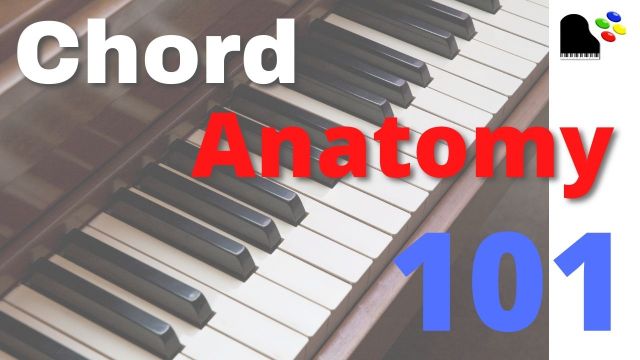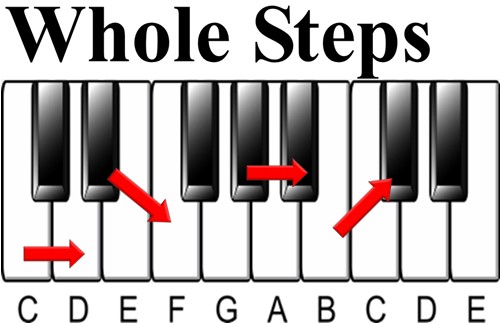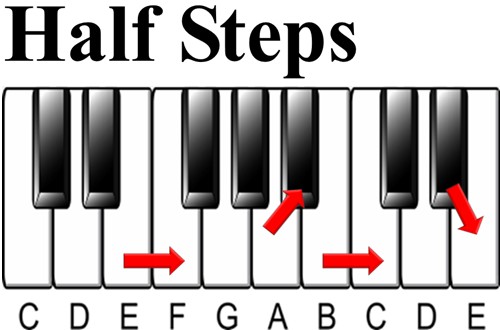So many things in life seem random even though they’re often not. When this is the case, it can be difficult to understand the nature of something.
For many years it seemed to me that the notes in a piece of music were random in nature which made it difficult for me to  understand.
understand.
One such thing in music are chords. Chords certainly aren’t random. They have an anatomy to them. Chord Anatomy can be defined as a study of the structure or internal workings of chords.
When you have a good understanding of how something works, it takes away the frustration of trying to utilize it. I want to share with you something called chord anatomy. This is essentially the structure or inner workings of notes that make up chords in music.
This chord anatomy concept can be easily understood by simply starting from the most basic chord and adding or altering tones within them to progressively transition to the most advanced chords.
If you can grasp this chord anatomy concept, any chord in any key will be yours to utilize with a clear understanding.
Whole steps & half steps
Understanding whole steps and half steps are absolutely essential to discern chord anatomy. At the same time, they’re incredibly easy to understand.
Whole step
A whole step is the distance from one key to the very next by skipping a key. It does not matter if the key you're on or the key you're moving to is black or white. Half step
Half step
A half step is the distance from one key to the very next key. It does not matter if the key you're on or the key you're moving to is black or white.
Major Chord
This is among the most basic chords. If you take a Major key of music and play only the 1st, 3rd and 5th tones, you have a Major chord aka a Major triad (triad meaning 3 referring to the number of notes)
Minor Chord
By lowering the 3rd of the Major chord down one half step, you have a minor triad.
Diminished Chord
Starting from a minor triad, you simply lower the 5th tone a half step and you have a diminished triad.
Augmented Chord
Starting from a Major triad, you simply raise the 5th tone up a half step and you have an augmented triad.
With the four triads that I just covered, you have the building blocks of virtually any popular song ever written. Of course I use the term virtually because these are simple triads and of course there are many songs with more sophisticated, or shall I say satisfying chords.
But from the most basic standpoint, these four types of triads will get the job done to play any popular song.
Suspended Chords
A suspended chord is a triad in which the third is omitted and replaced with a tone that is substituted for it. There are two different types of suspended chords. The Sus2 chord and the Sus4 chord.
The Sus2 chord
A Sus2 chord is a triad that consists of the 1st, 2nd and 5th tones of a Major key of music. A Sus4 chord is a triad that consists of the 1st, 4th and 5th tones of a Major key of music.
A Sus4 chord is a triad that consists of the 1st, 4th and 5th tones of a Major key of music.
Beyond Triads
All other chords beyond triads can be classified as extended chords. These types of chords are triads with one or more notes added to them. Many of these notes are referred to as color tones.
6th Chord
A 6th chord is a triad with a tone added to it that is a 6th degree away from the tonic of a Major scale. 6/9 Chord
6/9 Chord
A 6/9 chord is a triad with a tone added to it that is a 6th and 9th degree away from the tonic of a Major scale. 7th Chords
7th Chords
A 7th chord is a triad with a tone added to it that is a 7th degree away from the tonic of a Major scale. There are two different types of 7th chords. The Major 7th and the Dominant 7th chord.
The Major 7th chord
Starting with a Major triad, just add the tone that is 7 scale tones from the tonic. This is referred to as a Major 7th chord.

The Dominant 7th chord
Starting with a Major triad, just add the tone that is a minor 7th scale tone from the tonic. You can locate this tone by lowering the Major 7th tone down a half step. This chord is usually referred to simply as a 7th chord without emphasizing “dominant” to describe it.
Extended Major chords beyond 7th chords
Extended Major chords beyond 7th chords will always include either the Major 7th or flatted 7th without notating it. They’re implied. If there is a Major 7th in the chord, Major will be stated before the extension. If there is a flatted 7th in the chord, it will just notate the extension number.
9th Chord
A 9th chord is a Major 7 or a dominant 7th chord with a tone that is a 9th degree away from the tonic of a Major scale. It can be a Major 9th or a dominant 9th chord.
Major 9th Chord
Dominant 9th chord
11th chord
An 11th chord is a suspended chord with a tone that is a flatted 7th degree away from the tonic in a Major key of music. (The 3rd is omitted) A Major 11th chord is quite uncommon and not mentioned here.)
Dominant 11th chord Note: A Major 11th chord is quite uncommon and not mentioned here.
Note: A Major 11th chord is quite uncommon and not mentioned here.
An 11th chord can also contain the 9th and 13th tones respectively.
13th chord
A 13th chord is a 7th chord with a tone that is a 13th degree away from the tonic. It can be a Major 13th or a dominant 13th chord.
Major 13th chord Dominant 13th chord
Dominant 13th chord A 13th chord can also contain the 9th and 11th tones respectively.
A 13th chord can also contain the 9th and 11th tones respectively.
Minor 6th chord
A minor 6th chord is a minor triad with a tone added to it that is a 6th degree away from the tonic of a natural minor scale. Minor 7th chords
Minor 7th chords
A minor 7th chord is a minor triad with a tone added to it that is a 7th degree away from the tonic of a natural minor scale.
Minor 7th chord

Extended minor chords beyond minor 7th chords
Extended minor chords beyond minor 7th chords always include the 7th without notating it. It is implied.
Minor 9th chord
A minor 9th chord is a minor 7 chord with a tone that is a 9th degree away from the tonic of a minor scale. Minor 11th chord
Minor 11th chord
A minor 11th chord is a minor 7 chord with a tone that is an 11th degree away from the tonic of a minor scale. A minor 11th chord can also contain the 9th tone.
A minor 11th chord can also contain the 9th tone.
Minor 13th chord
A minor 13th chord is a minor 7 chord with a tone that is a 13th degree away from the tonic of a minor scale.  A minor 13th chord can also contain the 9th and 11th tones respectively.
A minor 13th chord can also contain the 9th and 11th tones respectively.
Altered chords
An altered chord is a 7th, minor 7th, or extended chord that contains a 5th or 9th tone that is raised or lowered (a half step) in any combination. It can also consist of a raised 11th tone.
7 flat 5
A 7 flat 5 chord is a dominant 7th chord with a lowered 5th tone.
Minor 7 flat 5
A minor 7 flat 5 chord is a minor 7th chord with a lowered 5th tone.
7 Sharp 9
A 7 sharp 9 chord is a dominant 7th chord with a raised 9th tone. 7 sharp 5
7 sharp 5
A 7 sharp 5 chord is a dominant 7th chord with a raised 5th tone.
Minor 7 sharp 5
A minor 7 sharp 5 chord is a minor 7th chord with a raised 5th tone.
7 flat 9 sharp 5
A 7 flat 9 sharp 5 chord is a dominant 7th chord with a lowered 9th and raised 5th tone.
Minor 7 flat 9 sharp 5
A minor 7 flat 9 sharp 5 chord is a minor 7th chord with a lowered 9th and raised 5th tone.
7 sharp 9 sharp 5
A 7 sharp 9 sharp 5 chord is a dominant 7th chord with a raised 9th and 5th tone.
7 flat 9 flat 5
A 7 flat 9 flat 5 is a dominant 7th chord with a lowered 9th and 5th tone. Minor 7 flat 9 flat 5
Minor 7 flat 9 flat 5
A minor 7 flat 9 flat 5 is a minor 7th chord with a lowered 9th and 5th tone.
These altered chords can also contain any combination of the 9th, 11th or 13th tones where they aren’t already altered within the chord.
The chord anatomy that I’ve outlined for you in this article is among the most useful in most styles of contemporary music. It encompasses pop, jazz, blues and rock just to name a few. Of course they can be played in any key.
By getting familiar with chord anatomy, you’ll increase your chord vocabulary to a degree that rivals that of any professional musician.
Until next time, Go Play!
Greg Lee
Latest posts by Greg Lee (see all)
- What is a minor/Major 7 Chord? - October 26, 2023
- 7 Chord Substitutions that Professionals Use - October 19, 2023
- 5 Simple Chord Tricks to Sound Amazing - October 5, 2023



